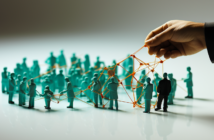Technology has transformed in ways that makes it penetrable into almost every segment of the world and business. It is a broad and multidimensional term hence today our focus is on discussing Artificial intelligence and Augmented Reality.
Artificial Intelligence
AI is just what the name suggests. It is the simulation of human intelligence by machines, especially by computer systems. So, what makes it so important in current times? AI can provide enterprises with insights into their operations that enterprises previously might have been unaware about. It simply performs tasks better than humans. This has increased the efficiency of enterprises immensely which in turn is helping them grab new business opportunities. On the contrary it also has a few cons, such as:
- It is expensive
- Requires deep technical analysis
- Lacks the ability to generalize from one task to another.
BRANDS USING AI FOR MARKETING –
Artificial Intelligence is a rapidly evolving technology that some of the most successful brands have been using for years. Gaining their rewards in terms of profits, media visibility and brand reputation.
Following are a few examples of how brands are using AI as an essential part of their marketing strategy.
- Amazon – The company is starting to venture into the fashion industry with Echo Look, an AI driven personal assistant. This market giant moving ahead as a leader has opened check-out free physical stores, which works with the help of AI-powered sensors and cameras. These sensors and cameras can tell exactly what the customer picked and charge accordingly.
- Alibaba- The company opened a physical “FashionAI” store in Hong Kong. The store is equipped with intelligent garment tags that detect when the tag is touched. Smart mirrors are installed that display clothing information and suggest coordinating items. In the future Alibaba is planning to connect it with a virtual wardrobe app. The app will allow the customers to access the items on an online website they tried on in-store.
- Starbucks- Starbucks uses AI by integrating it with the app. To make predictive analysis by processing the data and serving customers with personalized marketing messages. These messages include recommendations that customers could order on an outlet and offers to increase the customer’s average order value.
- Uber – Primary strategy of Uber is to connect riders to taxis. It has utilized machine learning algorithms to predict when people might need a ride in specific areas. This helps deliver a great service to its riders by proactively getting drivers on the road before they are needed.
- Google – One of the best and easiest examples is Google. It uses machine learning to understand how people use their services and then bring the appropriate changes to improve them.
Augmented Reality
AR is an interactive experience of a real-world environment where the objects that reside in the real world are enhanced by computer-generated perceptual information. AR can be delivered in multiple formats, including within smartphones, tablets and glasses. Hardware devices and input devices are all that an AR requires to function smoothly.This experience is seamlessly interwoven with the physical world such that it is perceived as an immersive aspect of the real environment. One of its drawbacks is, it can be computationally intensive. AR also hold multiple benefits for e-commerce, such as
- Elevate customer experience
- Reduce return-rate
- High conversion rate
- Less environmental impact
BRANDS LEVERAGING AR SUCCESSFULLY
- BON VIV – During the launch of their Spiked Seltzer, they presented the consumers with a 3D experience of a vending machine. Users were also given the opportunity to buy the Seltzer from their nearby stores or get it delivered. A few fascinating features of this campaign were, Instant online purchase, custom branded map with pins and activation with a social media link.
- Sephora – Sephora is a huge global name for the large variety of make-up they offer. It launched the online make-up artist tool. This tool detects the facial features of the user and lets them try on the make-up as if in a real Sephora store. The launch was made during the coronavirus pandemic making it a right move at the right time.
- Timberland – Back in 2014, Timberland surprised users with this AR trend. It allowed its shoppers to try on the clothes virtually, freeing them of all the hassle. It was first of its kind to launch back in 2014, making it a big hit in the market.
- Nike – Nike created an AR experience to promote its sneakers. All one has to do is get access through a mobile website. Aim the phone towards the sky and you’ll find a sneaker shape which then gives you access to stories from different music and dance artists who try to inspire young people. Campaign led to an increase of 32% in sales and 22% more visitors to the website.
- Oneplus – An AR campaign was held for the launch of their new flagship phone ‘NORD’. The event was broadcasted live through an app. AR gave the views a better look from all the angles. At one point during the event an exploded view of the phone was displayed. It is a first launch event via AR and more than 100,000 people watched the live-stream.
Today, the most successful enterprises have used AI to make improvements, win over the market and gain advantage on their competitors. As for AR, it will continue to grow through games like Pokemon Go and platforms like ARKit by Apple. Artificial Intelligence and Augmented reality still have to grow in a diverse way as the opportunities they hold are endless.




